Mapping Manhattan: How 10 Women See the City
by Becky Cooper
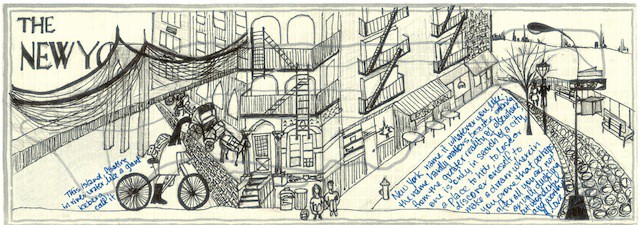
In 2009, when I was still an undergraduate student at Harvard College, I began a project called Map Your Memories: I walked the length of Broadway, handing out blank letterpress-printed maps for tourists and locals alike to fill out. I would eventually distribute 3,000 total maps and receive 300 completed maps back. I published 75 of the submissions in Mapping Manhattan: A Love (and Sometimes Hate) Story in Maps by 75 New Yorkers, which came out this past April.
Click on the maps to enlarge.
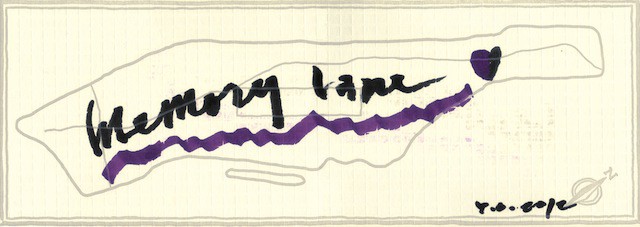
YOKO ONO
I made a list of mapmakers and she was on my list, but I wasn’t really sure if I was going to chance it because she’s such a legend. Then one day I was walking with a friend from out of town — I was showing him and his friend from home around New York — and we’re passing by The Dakota and I did the typical New Yorker thing: “This is the Dakota, this is where John Lennon was shot, and this is where Yoko Ono still lives, I think.” And my friend’s friend says right away, “Oh, she does.” And it turns out that 11 years ago, this guy’s friend ran into Yoko in front of The Dakota, and he takes a piece of paper out of his bag for her to sign. Instead, she rips it in half, and hands one half back to him, and she says, “If you meet me back here in exactly 10 years, I’ll give you the other piece and I’ll sign it.” He meets her a decade later — they corresponded over the years, I guess — and she returns the half and signs it for him.
So I got Yoko’s address from this guy, and I wrote her a letter. I put in a blank map, and I let my dad mail it because The Beatles are his god, and a month later I get an envelope back from The Dakota. There was a letter, it said something like, “Ms. Ono is generously excited to participate in your project. Here is her contribution.” I was floored! But I tell this story and people always say she that she has a knack for these wonderful magic tricks.
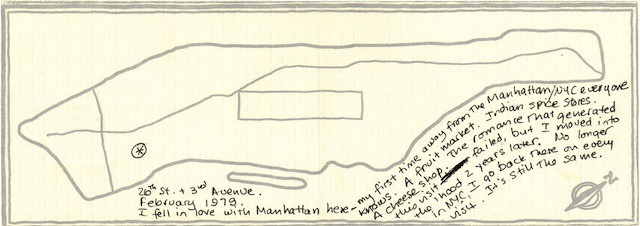
LITTLE INDIA
A lot of the maps in the book happen to be love stories, in one way or the other — maybe partially because I’m a sucker for those stories, but also largely because the maps that came back were, predominantly, these memories of real emotional poignancy. There were as many heartbreak maps as there were love story maps. In this one, her love of Manhattan is intimately connected to this love story of the reason she came to the city in the first place, and even if the romance went away, she still comes back to the city. A lot of these love stories were so mixed and mingled with the smells and sights and sounds of the city, and I think that’s what makes people so hopelessly connected to this place.
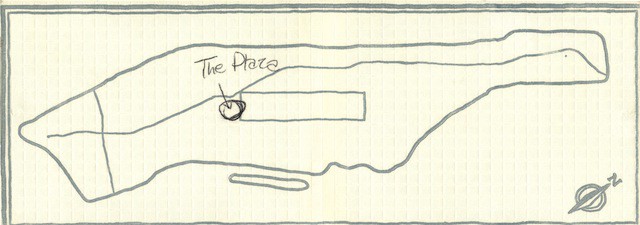
THE PLAZA
This is a condensed version of the letter she mailed with her map. She talks about her husband and their memories together. I tried to get the essence of it — her lifelong relationship to this fabled place, the way that it’s sort of been her Museum of Natural History, like it is for Holden: this is her place that doesn’t ever change all that much. And that’s her measuring stick for how much she’s grown. When I was handing out the maps, I encouraged people to fill the whole map with just one story, and that’s exactly what she’s done here:
I was probably around the same age as the young woman who approached me [with a blank map of Manhattan] when I first arrived in NYC, although my heart had arrived years before that — the Christmas of 1958, to be precise, when I was 7 years old and I received a copy of Eloise who took me through those “revolving doors with a P on them” for the first time. It was a circuitous route between the ages of 78 and 22 getting to Manhattan but one that I now realize was as magical as inevitable…
I haven’t been back to The Plaza since it finally re-opened even though I hear that The Oak Room is open to the public. I’m not sure why I haven’t gone in yet because I have no doubt the magic, along with Eloise’s portrait, is still there somewhere despite all the tarting-up and exclusivity that comes with a 5-mil-and-up-per-unit price tag. Perhaps I’m just waiting for the right moment — or an invitation. In the meantime, I’ll continue to look forward to the next time I walk through “the revolving doors with a P on them” and see what Eloise is up to these days.
Oooooh, I absolutely love New York! I absolutely do.

OFF THE GRID
This one I know is from a girl who was in college at the time, and she was looking to spend her summer ticking off this bucket list of things. If you look at the map it says things like, “learn to dance” and “figure out what to do when I grow up.” Her map is about her learning to step back and figure out who she is — literally off the grid. She just drew her own thing. I think it’s gorgeous, and it’s a sentiment that I know I can relate to, where you need to stop and pause before really beginning. And in her case she had a whole series of things that, together, almost feel as concrete as a place.
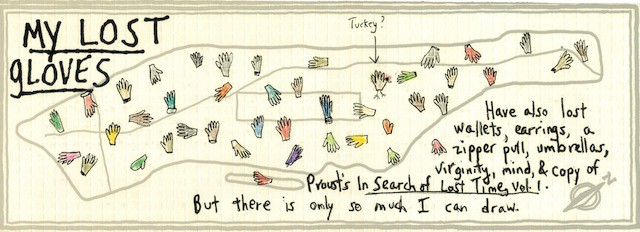
PATRICIA MARX
I love her writing and her humor. I knew she was the first woman on the Harvard Lampoon and so I was hoping her map would be as hilarious and earnest as she is. And I was not disappointed. I love the playful take, and how it touches on the deeper possibilities of the map — like, there’s only so much I can draw.
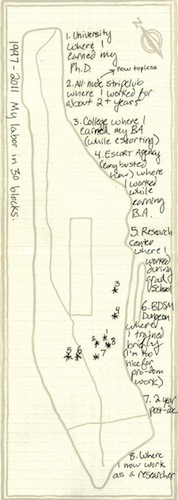
“PHYSICAL SCIENCES”
I really know as much as you know about this map. I don’t know who sent it or how old they are, or anything. I love the delivery. She’s not like, look at me, look at this double life, she’s just like, this is where I worked and this is where I earned the money to do this work. I loved the little asides — “I’m too nice for pro-dom work.” It’s perfectly done. You see that close proximity of the two lives and you can see how we all do sort of live double lives here. I don’t even think her lifestyle is that uncommon, but to see it laid out so bare is great.
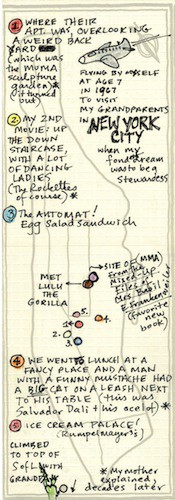
KATHARINE HARMON
She is one of my heroes in creative cartography. She wrote a book called The Map Is Art, which celebrates the aesthetic potential of cartography. This map is her at age seven, going to New York for the first time. I love that children’s perspective — you can see her childhood memories sliding into her understanding at a later time: the man in the restaurant turns out to be Salvador Dali, and a lot of dancing ladies turn out to be The Rockettes. She was experiencing New York as just this awesome place, not just the New York that is defined by what you miss. She wasn’t like, “oh my god, I need to go see The Rockettes” — but it turns out to be one of her most amazing memories of New York anyway. In the book I paired her map with all of these riots at Columbia, like the anti-war rally in Central Park’s Sheep Meadow. I paired those together because they both took place in 1967. It’s interesting to see the city from two so very different perspectives — the young girl compared with this guy in his late teens, early 20s.
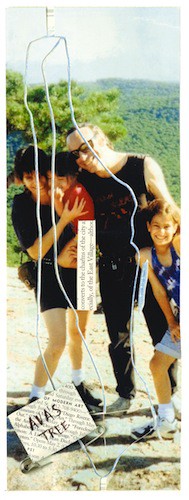
AVA IS HERE
This was from a girl who lost her sister, and she sent it with a note:
When I heard about [this project], I knew my map would have a photo…and initially I thought it would be of my sister, Ava.
When someone passes away, they are everywhere (at least I really believe that), and Ava is nowhere more than at every turn I make in the city. I struggled for a long (long!) time deciding how to realize my idea — photo on top? around? superimposed? — and then it hit me. The problem wasn’t how to insert Ava into the map. The problem was that it wasn’t just Ava who belonged there. My whole family is in my life in the city — the four of us as a unit — and the city courses through our veins, carrying us along its life like a river.
So here we are! The city is us, and we are the city.
P.S. Just in case you were wondering, Ava always wore safety pin earrings. Hence, the safety pin.
I was really connected to this map because it really captures sense of trying to separate one’s experience of the city from the city itself, which I think is really difficult. In compiling these, I was trying to find a way to make a book that is about New Yorkers as much as it’s about the city. I wanted to celebrate the fact that city is this dynamic evolving organism and that it’s often about relationships between people and places, rather than just these fixed coordinates.
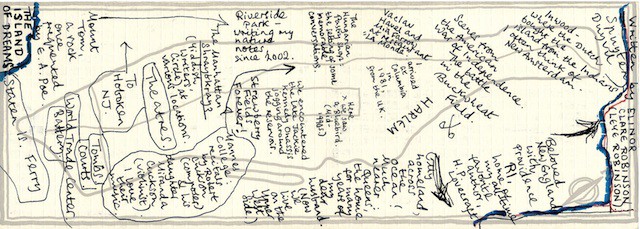
“ISLAND OF DREAMS”
What I love about this map is that it combines the history of New York with her own personal history. Up top you see she’s written scenes from the American War of Independence, and then further down it’s a Mia Farrow sighting at the restaurant, and even more simply, in Central Park, where “we saw a bluebird.” Or seeing Jackie Onassis running around her own reservoir.
I really like this mix of personal and collective memory. Both are sort of personal, in a way, because she can’t help but walk through Inwood without thinking of New Amsterdam. In a lot of other maps there’s this frontier line, where people don’t have any associations — historical or otherwise — within the area.
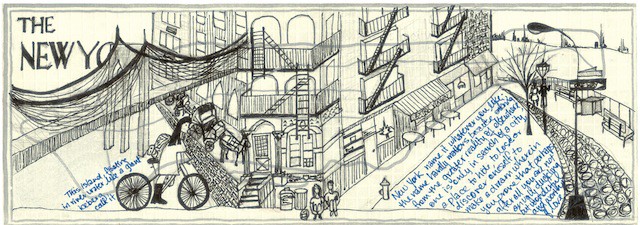
BECKY COOPER
Mine is a funny combination. I wanted to show people what my space looks like, which is totally lost — if a place doesn’t have an emotional peg to it it doesn’t actually exist in my head. These are sort of my best of New York highlights smushed all together. There’s Battery Park, where I always used to have lunch in high school, and there’s West 4th in the West Village, and then these nondescript buildings, because that’s sort of what the rest of Manhattan looks like in my head. And I included 59th street because of the horses and the beginning of Central Park. And then, randomly, the Brooklyn Bridge juts into the fire escape. There are a couple instances of me walking with some person, because I think my New York is a love story as much as the next person.
Beyond that, the quote underneath is from this Truman Capote essay, “New York.” The very beginning of the quote says, “It is a myth, the city… for anyone, everyone, a different myth” — I really liked that notion, that it’s a different myth for everyone. We all come here with a different idea about the place but with this notion to peruse and discover ourselves — and that sort of connection, despite the many different faces of it, is something I found over and over and over again in the city. It might even speak to why people did make these maps. It was their chance to both reflect on where they’ve come and how it resonates with them and share what their shape of the city is that they’ve worked so hard to carve. It may be self-selecting, but both the men and women who did maps included these moments of deep emotional significance — not just, this is where I live, this is where I work — and maybe that’s something New York brings out in people.
All maps excerpted with permission from Mapping Manhattan: A Love (and Sometimes Hate) Story in Maps by 75 New Yorkers, by Becky Cooper; foreword by Adam Gopnik. Published by Abrams Image.